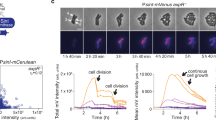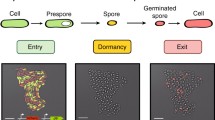Abstract
A simple family of models of a bacterial population in a time varying environment in which cells can transit between dormant and active states is constructed. It consists of a linear system of ordinary differential equations for active and dormant cells with time-dependent coefficients reflecting an environment which may be periodic or random, with alternate periods of low and high resource levels. The focus is on computing/estimating the dominant Lyapunov exponent, the fitness, and determining its dependence on various parameters and the two strategies—responsive and stochastic—by which organisms switch between dormant and active states. A responsive switcher responds to good and bad times by making timely and appropriate transitions while a stochastic switcher switches continuously without regard to the environmental state. The fitness of a responsive switcher is examined and compared with fitness of a stochastic switcher, and with the fitness of a dormancy-incapable organism. Analytical methods show that both switching strategists have higher fitness than a dormancy-incapable organism when good times are rare and that responsive switcher has higher fitness than stochastic switcher when good times are either rare or common. Numerical calculations show that stochastic switcher can be most fit when good times are neither too rare or too common.
Similar content being viewed by others
References
Arnold, L., 1998. Random Dynamical Systems. Springer, Berlin.
Arnold, L., Gundlach, V.M., Demetrius, L., 1994. Evolutionary formalism for products of positive random matrices. Ann. Appl. Probab. 4(3), 859–901.
Balaban, N.Q., Merrin, J., Chait, R., Kowalik, L., Leibler, S., 2004. Bacterial persistence as a phenotypic switch. Science 305, 1622–1625.
Bär, M., von Hardenberg, J., Meron, E., Provenzale, A., 2002. Modelling the survival of bacteria in drylands: the advantage of being dormant. Proc. Roy. Soc. Lond. B 269, 937–942.
Berman, A., Plemmons, R., 1979. Nonnegative Matrices in the Mathematical Sciences. Academic, New York.
Berman, A., Neumann, M., Stern, R., 1989. Nonnegative Matrices in Dynamical Systems. Wiley, New York.
Durrett, R., 1991. Probability: Theory and Examples. Brooks/Cole.
Elaydi, S., 2005. An Introduction to Difference Equations, 3rd edn. Springer, New York.
Grasman, J., 1987. Asymptotic Methods for Relaxation Oscillations and Application, Applied Math. Sci., vol. 63. Springer, New York.
Hadeler, K.P., Hillen, T., 2006. Coupled dynamics and quiescent phases. In: Math Everywhere-Deterministic and Stochastic Modelling in Biomedicine, Economy and Industry, Proc. Conf. Milano, 2005. Springer, Berlin.
Hennion, H., 1997. Limit theorems for products of positive random matrices. Ann. Probab. 25, 1545–1587.
Kaprelyants, A., Gottschal, J.C., Kell, D., 1993. Dormancy in non-sporulating bacteria. FEMS Microbiol. Rev. 271–286
Kell, D.B., S Kaprelyants, A., Weichart, D.H., Harwood, C.R., Barer, M.R., 1998. Viability and activity in readily culturable bacteria: a review and discussion of the practical issues. A. van Leeuwenhoek 73, 169–187.
Kussell, E., Leibler, S., 2005. Phenotypic diversity, population growth, and information in fluctuating environments. Science 309, 2075–2078.
Kussell, E., Kishony, R., Balaban, N.Q., Leibler, S., 2005. Bacterial persistence: a model of survival in changing environments. Genetics 169, 1807–1814.
Malik, T., Smith, H.L., 2006. A resource-based model of microbial quiescence. J. Math. Biol. 53(2), 231–252.
Seneta, E., 1973. Non-negative Matrices. Wiley, New York.
Thieme, H.R., 2003. Mathematics in Population Biology. Princeton University Press, Princeton.
Author information
Authors and Affiliations
Corresponding author
Additional information
This research was supported by NSF Grant DMS 0414270, Department of Mathematics, Arizona State University, Tempe, AZ.
Rights and permissions
About this article
Cite this article
Malik, T., Smith, H.L. Does Dormancy Increase Fitness of Bacterial Populations in Time-Varying Environments?. Bull. Math. Biol. 70, 1140–1162 (2008). https://doi.org/10.1007/s11538-008-9294-5
Received:
Accepted:
Published:
Issue Date:
DOI: https://doi.org/10.1007/s11538-008-9294-5




